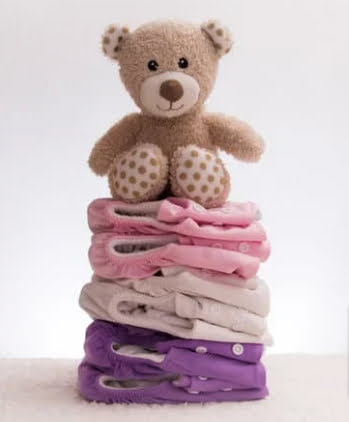Since 2014, there has been an explosion of eco-friendly alternatives to disposable diapers – with cloth diapers quickly becoming a favorite choice among environmentally-minded parents. But many individuals remain perplexed as to their operation – especially when it comes to dealing with inevitable poop! How do cloth diapers work with poop? In this article, we’ll delve into this fascinating world of cloth diapers and uncover all their intricacies when handling baby poop!

Modern cloth diapers have come a long way since their humble roots as pins and rubber pants of years past. Now, with sustainability and convenience in mind, modern cloth diapers provide multiple layers that work together to keep the baby dry and comfortable while simultaneously managing any messy incidents that arise.
The Anatomy of Cloth Diapers
Understanding how cloth diapers are constructed is essential to grasp how they work, especially with poop. Cloth diapers typically have three main layers:
Outer Layer
Cloth diapers typically feature an outer layer composed of waterproof materials like polyurethane laminate (PUL) or TPU that helps keep moisture locked within, keeping baby’s clothes dry.
Absorbent Layer
Beneath the outer layer lies the absorbent core. This layer soaks up liquids, like urine, and keeps your baby feeling dry. It’s often made from natural fibers like cotton, hemp, or bamboo, known for their high absorbency.
Inner Layer
The inner layer, in direct contact with your baby’s skin, is typically made of soft, moisture-wicking fabric. This layer keeps your baby comfortable and helps prevent diaper rash.
How to Remove Poop From Cloth Diapers Before Washing
Cloth diapering parents frequently have one of the biggest questions and concerns: how to effectively and efficiently remove poop from cloth diapers before tossing them in the laundry. Accurately dealing with baby poop is key for maintaining clean, odor-free diapers – let us show you the steps on how to effectively and efficiently do just that!
Prepare Your Supplies
Before you begin, gather the necessary supplies:
- Rubber Gloves: To maintain hygiene and protect your hands.
- Flushable Liners (Optional): These liners catch solid waste and can be flushed down the toilet, simplifying cleanup.
- Diaper Sprayer (Optional): A diaper sprayer is a handheld device that attaches to your toilet’s water supply and helps rinse off poop from the diaper.
Dump Solid Waste
If your baby is eating solid food, before washing you must remove as much solid waste as possible from his or her mouth. Here is how:
a. Use Flushable Liners (Optional)
- Add an eco-friendly flushable liner before placing the cloth diaper on your child. This will provide for better odor management, improved comfort, and easier disposal.
- When changing diapers, remove and flush away all solid waste in one go down the toilet.
- The cloth diaper should now have minimal solid waste left on it.
b. Shake Off Excess Waste
- Take the soiled diaper and hold it over the toilet bowl.
- Gently shake or tap the diaper to dislodge any remaining solid waste into the toilet.
Spray or Rinse
If there’s still residue left on your cloth diapers, a diaper sprayer or manual rinsing are both viable options to get it clean again. Here’s how:
a. Diaper Sprayer (Recommended)
- Position the soiled diaper over the toilet.
- Hold the diaper sprayer close to the diaper, aiming at the soiled area.
- Use a gentle but steady stream of water to spray off the remaining waste.
- Make sure to thoroughly rinse the entire soiled area until the water runs clear.
b. Manual Rinsing
- Make sure you fill a large basin or bathtub by filling it with hot water.
- Submerge the soiled diaper in the water.
- Gently agitate the diaper to help dislodge the poop.
- Drain the water and repeat the process until the diaper is poop-free.
- Wring out the excess water from the diaper.
Coterie Diapers vs Honest Diapers
Pre-treat Stains (if necessary)
If there are any stubborn poop stains on a diaper, pre-treating may help:
- Apply a small amount of light detergent and stain remover to the area of the stain.
- Rub the fabric gently to get the detergent in.
- Allow it to sit for a few minutes before proceeding to the next steps.
Wash as Usual
Once you’ve cleaned away any solid waste and pretreated any stains, follow your diaper manufacturer’s instructions when washing cloth diapers. Here are a few tips:
- Utilize detergent designed specifically to care for cloth diapers.
- Avoid using fabric softeners and bleach because they can damage the fabric and decrease absorbency.
- Select the appropriate water temperature for your diaper material (usually warm or cold water).
Dry Thoroughly
Make sure to dry your cloth diapers thoroughly after washing. You can either air dry them in the sun, which helps naturally disinfect and remove stains, or use a dryer on low heat. Avoid high temperatures as it can damage the fabric.
How do cloth diapers work with poop? Follow these steps to effectively remove poop from cloth diapers before washing, ensuring they remain clean, odor-free, and ready for reuse. Poop removal is a key aspect of cloth diapering. With the appropriate techniques and tools in your arsenal, it becomes part of a manageable diapering routine.
Benefits of Cloth Diapers

Cloth diapers offer several advantages over disposables.
Environmental Impact
Cloth diapers significantly reduce the waste that ends up in landfills, making them an eco-friendly choice.
Cost Savings
While the initial investment may seem high, cloth diapers can save you money in the long run, as they are reusable.
Health Benefits
Cloth diapers offer an eco-friendly alternative to disposables that reduces the risk of diaper rash and allergies associated with using disposable diapers.
Conclusion
Cloth diapers offer eco-conscious parents looking to reduce their carbon footprint an enjoyable chemical-free diapering experience for their infant. While more effort may be required and an initial investment made upfront may be necessary when switching over from disposables, the benefits outweigh any challenges related to clothing.
Cloth diapers are specifically designed to handle baby poop efficiently, with features like adjustable closures, elastic leg gaps, and disposable liners making the cleanup process simpler. Proper care including pre-washing, sunning, and using detergent ensures your cloth diaper remains odor-free and clean.
Cloth diapers make an excellent contribution to environmental sustainability by reducing waste, saving money over time, and supporting skin health for babies. So if you’re considering switching, don’t be put off from giving clothes a try – they could just save the earth too!
FAQs: How Do Cloth Diapers Work with Poop
Are cloth diapers more eco-friendly than disposables?
Yes, cloth diapers are more eco-friendly as they reduce landfill waste by being reusable and decreasing waste sent there.
Do cloth diapers leak more than disposable ones?
Properly fitted cloth diapers with elastic leg gaps are designed to minimize leaks, but like any diaper, they can leak if not used correctly.
How do I clean cloth diapers without damaging them?
Use a suitable detergent, follow recommended washing routines, and consider natural disinfection methods like sunning.
Can I use cloth diapers for newborns?
Yes, there are cloth diaper options designed specifically for newborns to ensure a snug and comfortable fit.
Do cloth diapers require more work than disposables?
While there is a learning curve and more laundry involved, the benefits of cloth diapers in terms of cost savings and environmental impact make the extra effort worthwhile.

Pingback: How to Tell Where Diapers Were Purchased? Track Your Diapers
Pingback: Who Makes Sam's Club Diapers? Quality, Savings, and More
Pingback: How to Store Diapers and wipes- A Guide for Parents
Pingback: Reusable Swim Diapers vs. Disposable- Making the Right Choice
Pingback: Coterie Pant vs Diaper: What Best Ones?
Pingback: Best All In One Diapers 2023 - Top 8 Picks
Pingback: 7 Best Cloth Diaper Starter Kits
Pingback: Best Bottoms Cloth Diapers (2023): A Comprehensive Guide
Pingback: Top 5 Tips on How to Change Baby Boy Diaper Without Getting Peed On
Pingback: How many diapers a day for 1 year old
Pingback: How Long Do Cloth Diapers Last? Parent's Guide 2024
Pingback: Where Can I Sell Unused Diapers? An Ultimate Guide
cialis no precription
cialis 20 mg cost
cialis prices in mexico
viagra online pharmacy usa
kroger pharmacy hours
price viagra
canada viagra online
when will cialis be generic
tadalafil 60mg
cozaar generic losartan
depakote level
ddavp bronchoscopy
can you take citalopram while pregnant
cozaar 50 mg uses
depakote maximum dose
ddavp and ms
long term effects of citalopram
tamsulosin eyes
cialis before and after pictures
tadalafil from india reviews
discount levitra online
women taking cialis